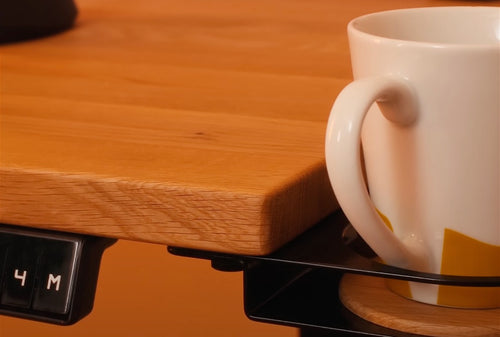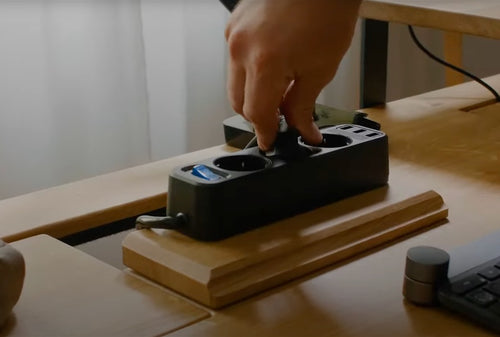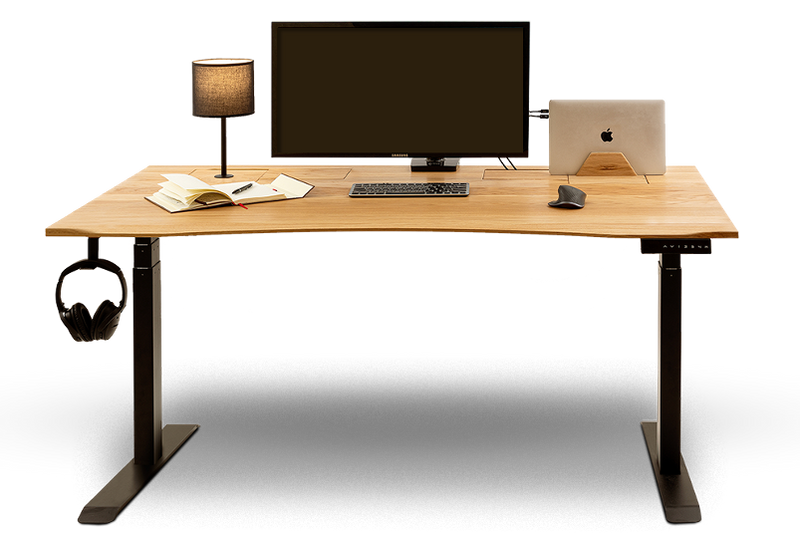Η σωστή στάση του σώματος κατά τη χρήση υπολογιστή
Πετάξτε το παλιό σας, μη εμπνευσμένο και φθαρμένο γραφείο και
ρυθμίστε σήμερα το νέο σας γραφείο ErgoHide.
Η σωστή στάση του σώματος κατά τη χρήση υπολογιστή είναι ζωτικής σημασίας για την πρόληψη του πόνου στην πλάτη, τον αυχένα και τους καρπούς. Παρόλο που πολλές θέσεις εργασίας απαιτούν παρατεταμένη καθιστική θέση, δεν χρειάζεται να αναπτύξετε χρόνιο πόνο. Βεβαιωθείτε λοιπόν ότι κάθεστε σωστά.
Εξασφαλίστε σωστή καθιστή θέση. Οι περισσότερες καρέκλες γραφείου διαθέτουν ρυθμιζόμενες πλάτες και καθίσματα, ενώ κάποιες έχουν και υποστήριξη μέσης. Δεδομένου ότι υπάρχουν πολλοί διαφορετικοί τύποι καρεκλών γραφείου με περισσότερες ή λιγότερες ρυθμίσεις, χρησιμοποιήστε τις παρακάτω οδηγίες για να διατηρήσετε τη σωστή στάση κατά την καθιστή εργασία:
- Οι μηροί σας πρέπει να ακουμπούν στο κάθισμα της καρέκλας.
- Πρέπει να υπάρχει γωνία 90 μοιρών μεταξύ των μηρών και των κάτω άκρων.
- Τα πέλματά σας πρέπει να είναι επίπεδα στο πάτωμα, σχηματίζοντας γωνία 90 μοιρών με τα κάτω άκρα.
- Η πλάτη σας πρέπει να έχει κλίση μεταξύ 100 και 135 μοιρών σε σχέση με τους μηρούς.
- Κρατήστε τα χέρια σας να ακουμπούν χαλαρά στο πλάι του σώματος.
- Χαλαρώστε τους ώμους και τον αυχένα, με τους ώμους πίσω και το στήθος ανοιχτό.
- Το πληκτρολόγιο και το ποντίκι πρέπει να βρίσκονται σε απόσταση προσέγγισης χωρίς να τεντώνετε τα χέρια ή να στρίβετε τους ώμους.
- Η οθόνη πρέπει να είναι σε άνετο επίπεδο θέασης χωρίς να καταπονείται ο αυχένας ή τα μάτια σας.
- Βεβαιωθείτε ότι τα αυτιά, οι ώμοι και οι γοφοί σας είναι ευθυγραμμισμένοι κατακόρυφα.
Τι να προσέχετε για να διατηρήσετε τη σωστή στάση στον υπολογιστή;
Βρείτε μια ουδέτερη θέση λεκάνης για σωστή καθιστή στάση. Η σωστή στάση κατά τη χρήση υπολογιστή απαιτεί μια ουδέτερη θέση της λεκάνης με τους γλουτούς σας να ακουμπούν στην πλάτη της καρέκλας. Για να βρείτε αυτήν την ουδέτερη θέση:
Τοποθετήστε τα χέρια σας κάτω από τους γλουτούς σας και βρείτε τα πιο προεξέχοντα οστά στους γλουτούς σας. Στρογγυλέψτε την κάτω πλάτη σας και πιέστε τη λεκάνη σας όταν βρείτε αυτά τα οστά. Θα πρέπει να αισθανθείτε μια πιο επίπεδη περιοχή στα χέρια σας. Στη συνέχεια, γείρετε τη λεκάνη σας προς τα εμπρός στην αντίθετη κατεύθυνση και μετακινήστε το βάρος σας προς το πίσω μέρος των μηρών σας. Η ουδέτερη θέση της λεκάνης βρίσκεται μεταξύ αυτών των δύο θέσεων. Τα οστά της λεκάνης θα πρέπει να είναι πιο έντονα όταν τα αγγίζετε.
Κατανείμετε ομοιόμορφα το βάρος και στους δύο γλουτούς και αποφύγετε την κλίση προς τη μία πλευρά. Το σταύρωμα των ποδιών και η κλίση μπορεί να είναι δελεαστικά κατά τη διάρκεια μεγάλων περιόδων καθίσματος, αλλά είναι μια κακή συνήθεια. Στρεβλώνει τη σπονδυλική στήλη και μπορεί να οδηγήσει σε προβλήματα όπως διαστρέμματα, καταπονήσεις της σπονδυλικής στήλης και δισκοκήλες. Επιπλέον, το σταύρωμα των ποδιών επιδεινώνει την κυκλοφορία του αίματος.
Μην προεξέχετε το κεφάλι σας προς τα εμπρός
Ελέγχετε τακτικά ότι δεν προεξέχει το κεφάλι σας προς τα εμπρός. Η προεξοχή του κεφαλιού και του αυχένα προς τα εμπρός είναι ένα συχνό πρόβλημα κατά την εργασία με υπολογιστή, και θα πρέπει να το αποφεύγετε συνειδητά. Για κάθε εκατοστό που το κεφάλι σας προεξέχει προς τα εμπρός, ο αυχένας σας επιβαρύνεται με επιπλέον 4,5 κιλά βάρους. Αυτό μπορεί να οδηγήσει σε διάφορα προβλήματα υγείας όπως πόνος στον αυχένα και την πλάτη, μυϊκές κράμπες, δυσκολία στην αναπνοή, πονοκεφάλους, ημικρανίες, αϋπνία, κόπωση, μούδιασμα και μυρμήγκιασμα στα χέρια και τις παλάμες.
Διαμορφώστε τον εξοπλισμό σας για σωστή καθιστή στάση
Η σωστή στάση του σώματος κατά τη χρήση υπολογιστή απαιτεί τη ρύθμιση του εξοπλισμού ώστε να ταιριάζει στο σώμα σας. Έχουμε ήδη συζητήσει το σωστό ύψος ενός όρθιου ή καθιστού γραφείου και έχουμε επίσης υπολογίσει το σωστό ύψος της καρέκλας και της οθόνης του υπολογιστή. Τα ρυθμιζόμενα όρθια γραφεία είναι η καλύτερη επιλογή για σωστή στάση, καθώς προσφέρουν προσαρμογή ύψους. Η δεύτερη καλύτερη επιλογή είναι ένα γραφείο που ταιριάζει στο ύψος σας.
Ελέγξτε όλες τις δυνατές ρυθμίσεις της καρέκλας γραφείου σας. Αν η καρέκλα σας διαθέτει οσφυϊκή υποστήριξη, ρυθμιζόμενα μπράτσα ή οποιοδήποτε άλλο είδος πρόσθετης στήριξης, προσαρμόστε τα ανάλογα με τις ανάγκες σας. Μπορείτε επίσης να αφαιρέσετε στοιχεία όπως τα μπράτσα και τα μαξιλάρια αν παρεμποδίζουν τη στάση σας. Αν τα πόδια σας δεν φτάνουν στο πάτωμα, σκεφτείτε να χρησιμοποιήσετε ένα υποπόδιο ή κάτι παρόμοιο για να τα σηκώσετε. Αν η πλάτη σας δεν ευθυγραμμίζεται και δεν υποστηρίζεται από την πλάτη της καρέκλας, χρησιμοποιήστε οσφυϊκή υποστήριξη.
Η οθόνη του υπολογιστή πρέπει να βρίσκεται σε απόσταση ενός χεριού, περίπου 45-60 cm από το κεφάλι σας. Το ανώτερο τρίτο της οθόνης πρέπει να είναι στο ύψος των ματιών. Η λανθασμένη τοποθέτηση της οθόνης μπορεί να προκαλέσει υπερβολική πίεση στον αυχένα και τα μάτια και μπορεί να οδηγήσει σε καταπόνηση του αυχένα, κήλες δίσκων και πονοκεφάλους.
Τοποθετήστε την οθόνη ώστε να ελαχιστοποιείται η αντανάκλαση και το έντονο φως. Τοποθετήστε την κάθετα στα παράθυρα και προσαρμόστε τις κουρτίνες ή τα στόρια εάν χρειάζεται.
Για σωστή στάση των χεριών, ρυθμίστε το ύψος των μπράτσων ώστε οι αγκώνες σας να σχηματίζουν γωνία 100-110 μοιρών. Με όρθια στάση, το πληκτρολόγιο πρέπει να έχει μια ελαφριά κλίση, και τα χέρια σας να είναι ελαφρώς χαμηλότερα από τους αγκώνες σας. Διατηρήστε τους καρπούς σας ευθυγραμμισμένους και ελαχιστοποιήστε την κίνηση πάνω-κάτω.
Ένα στήριγμα πληκτρολογίου μπορεί να βοηθήσει στη διατήρηση των σωστών γωνιών για τα χέρια και τους καρπούς σας. Χρησιμοποιήστε το στήριγμα πληκτρολογίου όταν δεν πληκτρολογείτε. Αποφύγετε να το χρησιμοποιείτε κατά την πληκτρολόγηση, καθώς η στρέψη των καρπών μπορεί να προκαλέσει καταπόνηση. Συνιστάται η χρήση συντομεύσεων πληκτρολογίου, καθώς μειώνουν τη χρήση του ποντικιού.
Κρατήστε το τηλέφωνό σας σε εύκολη πρόσβαση, αλλά μην κρατάτε το ακουστικό με τον ώμο σας κατά τη διάρκεια κλήσεων. Αντ' αυτού, χρησιμοποιήστε ακουστικά ή τη λειτουργία ανοιχτής ακρόασης.
Κάντε διαλείμματα από την καθιστή εργασία στον υπολογιστή
Βεβαιωθείτε ότι κάνετε τακτικά διαλείμματα από την καθιστή εργασία και τεντώστε το σώμα σας. Τα διαλείμματα πρέπει να γίνονται τουλάχιστον μία φορά την ώρα, κατά προτίμηση κάθε 30 λεπτά. Σηκωθείτε και κινηθείτε κατά τη διάρκεια των διαλειμμάτων. Αυτό βοηθά στην ανακούφιση του υπάρχοντος πόνου, αποτρέπει τη μυϊκή δυσκαμψία και μειώνει τον κίνδυνο εμφάνισης νέου πόνου.
Δοκιμάστε απλές ασκήσεις stretching για να ανακουφίσετε και να τεντώσετε τους μυς σας και να βελτιώσετε την κυκλοφορία του αίματος. Για όσους υποφέρουν από πόνο στην πλάτη, τα καθίσματα είναι μια εξαιρετική άσκηση. Οι καταλήψεις για 15 λεπτά την ημέρα βοηθούν στη διατήρηση της καμπυλότητας της οσφυϊκής μοίρας της σπονδυλικής στήλης, μειώνουν τη συμπίεση της σπονδυλικής στήλης και βελτιώνουν την κινητικότητα των ισχίων.
Τα μάτια σας χρειάζονται επίσης διάλειμμα κατά την εργασία σε υπολογιστή. Η κόπωση των ματιών μειώνει τη συγκέντρωση και μπορεί να οδηγήσει σε κακή στάση σώματος, καθώς μπορεί να αρχίσετε να γέρνετε και να ακουμπάτε στο τραπέζι. Για να αποφύγετε την κόπωση των ματιών, κοιτάξτε κάτι μακρινό (τουλάχιστον 6 μέτρα μακριά) για 20 δευτερόλεπτα κάθε 20 λεπτά. Τα γυαλιά με φίλτρο μπλε φωτός μπορούν επίσης να βοηθήσουν.
Εκτός από τα μάτια, οι καρποί σας διατρέχουν επίσης κίνδυνο κατά την εργασία στον υπολογιστή. Μπορείτε να τεντώσετε τους καρπούς σας τεντώνοντας το χέρι σας μπροστά σας και λυγίζοντας τα δάχτυλά σας προς τα πίσω με τη βοήθεια του άλλου χεριού σας. Μπορείτε επίσης να πιέσετε μια μπάλα τένις για τέντωμα των καρπών.
Πετάξτε το παλιό σας, μη εμπνευσμένο και φθαρμένο γραφείο και
ρυθμίστε σήμερα το νέο σας γραφείο ErgoHide.
Θέλετε να ξέρετε γιατί; Γιατί με το ErgoHide μπορείτε:
Θα αλλάξει τον τρόπο που εργάζεστε: Μοναδική λύση διαχείρισης καλωδίων για έναν τακτοποιημένο χώρο και μοναδικά πρόσθετα που θα αντικατοπτρίζουν το προσωπικό σας στυλ.
Θα μεταμορφώσει το γραφείο σας σε έναν χώρο έμπνευσης και ομορφιάς: Κάθε γραφείο ErgoHide κατασκευάζεται από πιστοποιημένο και τοπικά προμηθευόμενο στερεό ξύλο δρυός ή καρυδιάς. Κάθε επιφάνεια γραφείου είναι εμποτισμένη με λάδι και ελέγχεται προσωπικά πριν την αποστολή, εξασφαλίζοντας μακροχρόνια ανθεκτικότητα, διαχρονικό στυλ και την φυσική ομορφιά του ξύλου.
Θα υποστηρίξει μια τοπική εταιρεία της ΕΕ και την αποστολή μας για αειφορία: Μάθετε περισσότερα στη σελίδα μας About Us, αλλά συνοπτικά – ακολουθούμε μια πρακτική προσέγγιση στην αειφορία. Για κάθε 100 γραφεία που πωλούνται, φυτεύουμε ένα δέντρο για να βοηθήσουμε στην ανανέωση των φυσικών πόρων που χρησιμοποιούμε.
Είστε πάντα στην ασφαλή πλευρά μαζί μας: Η εγγύησή μας για επιστροφή χρημάτων 180 ημερών ισχύει ακόμη και για γραφεία ειδικών διαστάσεων και ειδικές αιτήσεις, δίνοντάς σας άφθονο χρόνο για να δοκιμάσετε το γραφείο ErgoHide πριν πάρετε την τελική σας απόφαση. Επιλέξτε την ιδανική σας ρύθμιση και επωφεληθείτε από την ΔΩΡΕΑΝ αποστολή – κάντε κλικ εδώ για να αρχίσετε να ρυθμίζετε το νέο σας γραφείο ErgoHide τώρα!

 Καθαρό ξύλο
Καθαρό ξύλο
 Διαχείριση καλωδίων
Διαχείριση καλωδίων
 Πρόσθετα
Πρόσθετα
 LED εποξικής ρητίνης
LED εποξικής ρητίνης



















